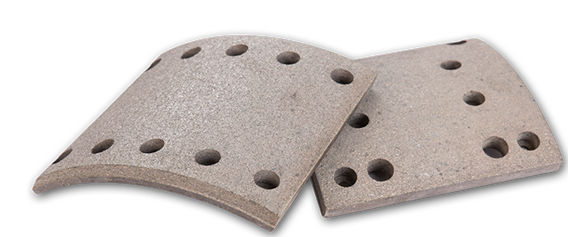BRAKE LININGS

Drum brake pads are made for light and heavy commercial vehicles. Our products have a moderate / high coefficient of friction and very good resistance to heat and wear. Formulations classified according to the Terms of Use are offered with different brands. Most products have certification documents related to ECE R-90.
BRAKE LINING PERFORMANCE TEST
Braking torque / deceleration acceleration measurements are performed in brakes under continuously changing speed, temperature and pressure conditions by test condition simulation and friction coefficients
BRAKE COVER SOUND TEST
The brake pad to be tested is connected to the tester together with the spring / damper assembly of the vehicle to increase the accuracy of the test. It is subjected to a test in which the braking conditions are constantly changing, and the frequency measurement is carried out with the sound intensity occurring.
BRAKE PAD WEAR TEST
Under the conditions specified in the wear test standard, the tests for the discs / faces in connection with the utility model or the
Temperature performed. The results are measured in mm and grams and the amount of wear is determined.
BRAKE PAD COMPRESSIBILITY TEST
In this test, the pad is exposed separately at room temperature and after 400 degrees of heating to a pressure of 160 bar. The amount of compression at the beginning is measured. This test also measures the amount of expansion and heat transfer that occurs in the head. The results indicate that the degree of tightness is considered low and the risk of producing noise is high. The high amount of jamming causes problems with the pedal feel for the smooth gait. The ratio of stiffness to thickness is as small as 2% at room temperature and as small as 5% at 400 degrees.
BRAKE CUFF CUT TEST
In this test, the adhesive strength between the disc blade and the brake pad is measured. The test machine must measure the shearing force of the starting shear over the shear force of 350 N / cm 2. If the brake lining is over this value, at least 80% of the brake pad must remain on the plate.
TESTS WITH KRAUSS TEST MACHINE
When the R & D process and series production of the brake pad are complete, the Krauss test machine and friction coefficient of the pad and abrasions are monitored on each side during production.
BRAKE PADS PRODUCTION BATCH CHECK
All tests are performed at each party where the production takes place. During production, all tests such as hardness, density, flexural strength are performed for quality control. Therefore, batch control is also performed on manufactured products.
TEST ON VEHICLE
Under actual conditions, the performance of the brake pad is tested with the brake pad mounted on the vehicle to determine factors such as wear. The first brake on the vehicle is called the original brake. The original or equivalent brake pad must be used for service and replacement. The tests should be performed according to the ECE R90 specification to refer to equivalent brake pads, and these tests should be approved with positive results. As RK Austria we have all tests under the ECE R90 and validate them with an E1 number. By constantly testing our products, we continuously improve our quality. This E1 number, which is awarded after the tests by the authorized institutions, proves that the brake pads have the same performance as the brake pad installed in the first assembly.
TECHNICAL INFORMATION ABOUT THE BRAKE LINING
In all small vehicles, large brakes are used as wheel brakes, with brake systems providing friction and deceleration / stopping. These brakes, which are typically used directly on the bike, perform two important functions. Constant stopping / braking torque and kinetic or potential energy, which is converted into heat energy by friction and destruction of this heat. This system is divided into two parts, drum and disc brake. When the user depresses the brake pedal, pressure is generated by a hydraulic / pneumatic or hydropneumatic system and this pressure is transmitted to the brake cylinder. The stroke of the brake cylinder is controlled by the pistons. With this force, the paddle pushes the disc / drums and inflicts friction, which allows the kinetic or potential energy to be converted into heat energy and to slow down or stop the vehicle. The braking power of a start depends mainly on the friction coefficient (μ) between the disc and the Drum off. The fact that the friction coefficient is not in the correct position will lead to different problems. If this value is high, the braking distance is extended if it is too low to block at very low pedal pressures. Under the conditions in these two conditions the danger is born. For this reason, in the brake pad method, it is necessary to first obtain the friction coefficient suitable for the vehicle and produce products having this coefficient. As RK Austria, all product groups are tested with tests for these conditions.
The appropriate coefficient of friction of the starter is calculated separately for each vehicle in accordance with the technical data of the vehicle, and the ideal curve is determined according to
Determined braking force distributions. The internal braking factor C *, which provides the best conditions for this curve, is determined. Internal Braking Factor C * is the percentage of the compressive force of the surrounding forces. The internal brake factor determines the brake torque, deceleration acceleration, or braking distance that the vehicle manufacturer / model predicts for any brake pressure. The internal brake factor also determines the coefficient of friction, which the vehicle manufacturer expects from the outset for the model. As RK Austria, we expect a good brake pad such as SAFE, COMFORTABLE and EKONOMIC.
The factors, to be sure, are the constant coefficient of friction, which provides the internal braking factor according to the make / model. The constant coefficient of friction is related to good performance throughout braking, cold braking, hot braking, post-braking, varying brake pressure and braking at different speeds.
At the same time, it is important for safety to have a fast and good surface finish, free of expansion, shear strength, non-flammability, dirt, rust and dust. The comfort which RK Austria expects from its paddocks lies above all in the additional quality of the pedal force, in noise, pollution and odor nuisance. The economic characteristics that we put on the brake lining are that the wear of the brake pad is small and long-lasting, the wear on the disc or drum is low and the weight loss on both parts is low. Our expectation from the beginning is that the relationship between the criteria we are talking about is well established. Each of these criteria influences the other and each criterion changes.
Taking all these criteria into consideration, a brake pad should be considered. Any other review is not very healthy and leads the user astray. In addition, the brake pad is only one of the parts in the brake system and the other parts in the system have a major impact on the system. Problems and conditions of use such as discs,
Drum surfaces, shoe lugs, brake cylinders, bellows and S-glass can affect the performance of the brake pads and brakes and negatively affect our expectations.
RK Austria, with a high-quality sales marketing network, is now located throughout Europe and the Middle East
BRAKE PADS
PRODUCT
CONTACT
MAPS
Tullnerstraße 87 A-3425 Langenlebarn Austria
+43 (0) 2272 82239
+43 (0) 676 72 26 473
info@rk-austria.at
export@rk-austria.at
sales@rk-austria.at
BRAKE SHOE
BRAKE DISK
TRUCK BRAKE DISK
BRAKE LININGS
TRUCK BRAKE DISK
BRAKE DRUMS
TRUCK BRAKE DRUMS
Copyright Ⓒ 2019 - All rights reserved


